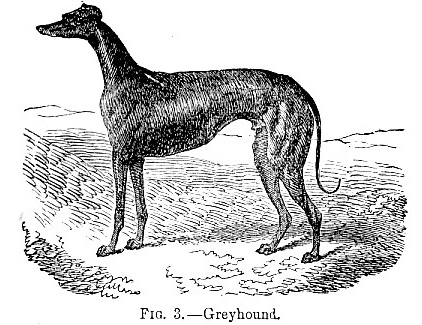II. GREYHOUNDS. – Representations on Egyptian monuments prove the existence of the greyhound race of dogs at least 3000 years ago, and the silky-haired breeds existing in Egypt, Arabia, and Persia at the present day are probably the slightly modified descendants of those ancient forms.
The numerous varieties of this race may be conveniently grouped into the wire-haired and smooth-haired breeds, -- of the first of which the Irish Greyhound or Wolf-dog is an example. In former times this magnificent breed was employed in Ireland in hunting the wolf and the stag, but the extirpation of these beasts of chase led to the neglect and consequent degeneracy of the breed, and it has now become extinct in that country. It was probably introduced from the sister isle into Scotland, where its modified descendent, the Scottish Deerhound, in hunting the stag still bears testimony to the great strength and agility of its progenitor.
The Old English Greyhound was only allowed to kept by the nobles and princes, and the killing of it was, under the old game laws, a felony punishable by death. It was employed in coursing the red deer, and Queen Elizabeth is said to have witnessed, on one occasion, the pulling down of 16 bucks by greyhounds. These must have been much more powerful animals than the modern English breed, which, however, is regarded as the finest of the smooth-haired greyhounds. In speed and wind it is unrivalled, all other points having been sacrificed to these by breeders. It has thus almost lost the power of scent, and is the only dog that hunts by sight alone, hence probably the name gazehound formerly applied to it.
According to Daniel, its speed on flat ground is little inferior to that of a racehorse, while on hilly ground it is probably superior to it. Every part of its body is suggestive of activity and speed -- long and pointed muzzle, the narrow head, thin neck, chest deep and flacks contracted, long slender legs, and the tail narrow and curved upwards.
It is exceedingly docile, good-tempered, and affectionate. The colour varies in different breeds, and even in individuals of the same breed. Bell suggests that the greyhound may owe its name to the prevailing colour of the original stock; while others, with more probability, derive it from the ancient British grech or greg, a dog.
The Italian greyhound is a small but exceedingly elegant and delicate breed, relegated in this country to the parlour as a ladies’ pet.
The Lurcher is supposed to be the result of a cross between the rough greyhound and the sheep-dog, having the sharp, pointed muzzle of the former, and wowing its diminishing height but greater stoutness to the latter. It resembles the sheep-dog still more in its great intelligence, and in devotion to its master. That master is usually the poacher, and in his illegal pursuit of game, the keenness of scent, the cunning, and absolute silence of this dog render it the most suitable of all for such nocturnal work. It waylays the rabbit returning to its burrow, its cunning circumvents the hare where its speed would not avail, and it has strength sufficient to pull down the fallow deer. According to Colonel Smith these dogs sometimes run wild when their owners are captured and imprisoned, and when thus catering for themselves they have regularly hunted with hounds.
Read the rest of this article:
Dog - Table of Contents
